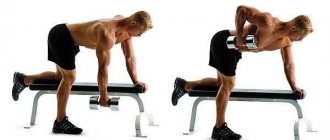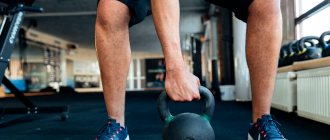Why do you need stretching?
Twine is not only beauty and grace, it is also a huge benefit. Thanks to flexible and plastic muscles, the body becomes stronger, more attractive and retains youth longer.
First of all, it is recommended to do stretching in combination with other activities to reduce pain.
How stretching affects the body:
- stimulates blood circulation;
- develops body flexibility;
- relieves tension in the body;
- eliminates the risk of muscle strain.
Often, during sports training, stretching is neglected. But stretching exercises are very important for strengthening muscles. Any workout must be completed with a stretching cool-down.
Without which you cannot perform the exercise
Why is a warm-up required for splits? Anyone who wishes to perform such an exercise must warm up their body. This is necessary for several reasons:
- Without warming up, you can get injured.
- By warming up you can increase your strength.
Warming up for the splits is as necessary as washing your hands before eating. It must be done without fail, since the consequences may not be entirely pleasant. When performing a warm-up complex, you must remember that this process should be approached thoroughly. In other words, don't pretend that you're warming up. You need to strictly perform certain exercises, as this will help you learn how to do the splits in a fairly quick period of time.
Contraindications
Despite the many positive effects on the body, there are the following contraindications for stretching:
- serious spinal injuries;
- too frequent lower back pain;
- inflammation of the joints (especially the hip);
- severe bruises;
- fractures;
- hypertension;
- hernias;
- osteoporosis;
- high blood pressure;
- pregnancy (exercises can be allowed, but with caution and under the supervision of a trainer for pregnant women).
Contraindications also include discomfort during stretching. If sharp pain occurs during training, or crunching is often heard, then you need to stop exercising. You should also not stretch if you have recently healed fractures or injuries without consulting a surgeon.
Advantages of the warm-up complex
What are the benefits of warming up for the splits? The positive aspects should be listed. They are as follows:
- The plasticity of muscle fibers increases.
- With the help of a warm-up complex, blood circulation improves and muscles are saturated with oxygen.
- Due to improved blood circulation, the amount of lactic acid will be reduced to a minimum.
- Increases flexibility of tendons and joints. Accordingly, the likelihood of injury is reduced.
- The performance of muscle fibers increases.
And warming up for the splits will give you all these benefits. But many people simply don’t want to do it. And completely in vain.
Best time to practice
Stretching exercises for splits can be performed at any time of the day, but taking into account certain characteristics of the body. In the first half of the day, you can stretch as morning exercises, performing the gentlest movements possible.
Thus, the body will wake up and be filled with energy. A more thorough workout is best done in the afternoon. By evening, the muscles will be prepared for stretching, and the session will be more effective.
You can also do stretching as an additional workout or warm-up. For example, if you stretch before strength training, the exercises will be easier. After a strength workout, stretching helps you relax and relieve muscle pain.
Types of stretching
There are three main types of trainers: static, dynamic and ballistic.
Static stretching is called passive stretching , in which we stretch a relaxed muscle. It is the most frequently used and is used in gymnastics, as well as as the final part of training in other sports.
Dynamic stretching is one in which the work of a muscle is combined with its stretching. It has found its application in dancing and martial arts. The advantage of this type of stretching is that it is both stretching and preparation for training, and it also provides gradual consolidation of the desired element, for example, batman in ballet or setting up a kick in martial arts.
How to Warm Up Before Stretching for Children Beginners
Before starting the warm-up, you should thoroughly warm up your muscles. To do this, it is necessary to warm up for both children and adults, and even those who have been doing the splits for a long time. What, under no circumstances, should be neglected is a warm-up warm-up.
Before stretching, children should spend at least 10 minutes warming up.
You can do the following exercises:
- walking in a circle, slowly accelerating and turning into running;
- raising and lowering your arms while standing still to restore breathing after running;
- bending towards the legs, forward and backward;
- rotation of the torso;
- rotation of the knees brought together;
- rotation of feet
Warm-up for adults:
- jumping rope (possibly without, on the spot);
- wide squats;
- lunges;
- standing body bends;
- sitting body tilts;
- Butterfly exercise.
How to warm up properly before stretching: exercises, tips
Warm Up Before Stretching
So, before you try stretching for beginners at home, it's important to warm up. Without warming up your muscles, you risk serious injury. At best, you will only get away with a minor sprain, but in more complex situations the consequences can be much more serious.
So, just do a simple warm-up:
- First, stretch your joints - twist them, bend them
- Then spend 5-7 minutes doing cardio training or running in place. Jumping rope also helps a lot
When your muscles are already warmed up, you can safely begin to stretch them.
The most effective stretching exercises for splits
Stretching exercises for splits come in different levels of difficulty.
However, there are several exercises that are the most effective, the regular implementation of which will help even the most inflexible people do the splits:
- exercise “fold”;
- double twists;
- bending over with your hands “clasped” behind your back;
- bending to the feet;
- bending forward;
- deep lunges (forward and with the shin raised);
- stretching while standing.
Don't miss the most popular article in the section: Body drying for girls. Training program, detailed nutrition menu for the month by day.
Exercises "fold"
The exercise is a deep bend of the body towards straight legs. When performing the exercise, the spine and back muscles of the thighs are stretched. Performing a “fold” promotes active stretching of the muscles; the abdominal muscles are also toned.
You need to perform the exercise while sitting on the floor:
- legs need to be brought together;
- straighten in front of you;
- extend your arms in front;
- reach with your body towards your legs;
- you need to stay in this position for 15 seconds;
- then return to the original.
The ideal exercise is performed when the body lies completely on the legs.
Longitudinal half twine
The longitudinal half split helps to better stretch the muscles, preparing them for a full longitudinal split.
To correctly perform a longitudinal half-split you need:
- sit on the floor, turning your body to the right;
- fold your right leg at the knee and extend your left leg back by the body;
- transfer your own weight to the folded right leg;
- Stretch your head up and maintain this position until there is a strong tension.
This is a longitudinal half-split on the right leg. The same must be repeated with the left leg folded.
Double crunches
When performing a double twist, the oblique muscles of the abdomen, back and legs are stretched. The technique seems very easy at first, but after several repetitions, the effect of the exercise is felt.
To perform the exercise you need:
- sit on the floor, legs wide apart;
- First, pull the foot of your right leg towards you, bending your leg at the knee;
- grab your left knee with your right hand;
- Place your left hand on the back of your head and turn your body to the left.
Then repeat the same thing, folding your left leg and turning your body to the right.
Bends with hands “clasped” behind your back
It is better to start stretching exercises for splits with simple workouts, for example, bending over with your hands “locked.” This exercise works the shoulder girdle, back muscles and hamstrings. Helps the body warm up for more difficult exercises.
Starting position: standing, feet at shoulder level:
- You need to clasp your hands behind your back and slowly bend your body back;
- after a noticeable tension appears in the chest and above the knees, without releasing your hands, lower your body down;
- you need to raise your straightened arms “locked” perpendicular to the body;
- You need to strive to ensure that your chest touches your thighs;
- in this position you need to stay for 5 seconds and return to the starting position.
Bends to one leg
Bends to the leg help stretch the back muscles of the legs and lower back muscles. The muscles that will work when doing the splits are used. You need to perform the exercise slowly and stretch so that it is comfortable, not painful.
At this level of performing the exercise, bending towards the leg to stretch, you can already try doing the splits
To perform leg bends you need:
- sit on the floor;
- stretch your legs together;
- place the right foot to the left thigh so that the right knee lies on the floor;
- spread your arms to the sides, and alternately, with each hand, try to reach your left foot;
- reaching out with one hand to your foot and holding for 5 seconds;
- return to the starting position and stretch with the other hand;
- then repeat the same with the other bent leg.
Bend forward with legs open
Bends forward with open legs are performed while sitting on the floor:
- with your legs spread wide apart, you need to touch the floor with your chest;
- To do this, you can turn your hips inward and move your pelvis forward;
- to hold the position, you can grab your feet with your hands;
- You need to repeat this exercise every workout.
Deep lunges forward
Deep lunges stretch your leg muscles better than any other exercise. In addition, it perfectly tightens the gluteal muscles.
To do this you need:
- lunge with your right leg, lower your left leg to your knee;
- rest your hands on the floor and place your right foot between your hands so that tension appears in the tendons under the knee;
- After pausing a little, change legs.
Deep lunge with calf raise
You need to perform the exercise against the wall:
- do a regular lunge with one leg;
- rest the toe of the other leg against the wall and the knee on the floor;
- Thanks to the raised shin, the muscles of the buttocks and thighs will stretch.
Power stretching while standing
Stretching exercises for splits can be strength-based. With power stretching, instead of pressing the muscles with body weight, stretching occurs using the force of the arms, for example.
While standing you must:
- First bend one leg at the knee, then extend it to the side;
- take the foot of the outstretched leg in your hand and pull the leg up;
It is worth noting that this exercise is designed for beginners, since not everyone can lift their leg in the air. But if you manage to do power stretching, then doing the splits will also soon be possible.
Side plank stretch
Side plank exercises are one of the most difficult exercises to perform due to the fact that it is difficult to maintain balance, but they are the most effective.
Need to:
- stand in a side plank, leaning on your left leg and arm;
- raise your right leg up;
- grab your leg with your right hand, preferably by the foot;
Most likely, it won’t work right away, but you need to try.
Vertical twine
Vertical splits are somewhat similar to standing power stretches.
You need exactly the same:
- raise one leg in the air as high as possible;
- lower your body towards the other leg.
The exercise is quite difficult, you don’t need to try to do it right away. It's actually a split, just in a vertical position. Of course, you can do a vertical split only after enough practice time.
Twine with support
Before doing the splits for the first time, it is better to try with support. As support, you can use a brick, a small ball, a fitness cube or a towel folded several times.
Need to:
- make a deep lunge;
- place the “belay” under the thigh of the leg, which is in front of the body;
- body weight needs to be shifted to the back leg;
- Stretch the front leg as much as possible;
By performing splits with support, you can learn to maintain balance, as well as feel progress from training.
Exercise No. 3
Deep forward lunges and their variations
What could be simpler and more convenient than stretching the leg muscles in such a lunge? In addition, this exercise is even too good for stretching. Lunge forward with your foot. Place your hands on the floor. The leg should be between them. Place your left knee on the floor. If you can, lower yourself onto your elbows. Press your body against your right leg. Stretch your hips towards the floor.
Exercises while standing
The most popular stretching exercises are usually difficult to perform, so you should start training with simple stretches for the splits.
You can do the following exercises while standing:
- swing your legs (forward, backward, to the sides) - you can perform the exercise by leaning your hand on a wall or chair. If it works without support, even better;
- body tilts - you need to place your feet shoulder-width apart, grab your elbows with your palms and bend down as much as possible. Try to touch your chest with your thighs;
- side lunges - spread your legs wide, cross your arms over your chest. Perform smooth lunges from one side to the other;
- bridge against the wall - stand against the wall, raise your arms up and place your palms on the wall. Slowly lower your body back, helping yourself with your hands. You may not be able to get down on the floor the first time; the main thing is to avoid discomfort in your back.
Exercise No. 2
Folds are the basis of splits!
Remember the expression: “fold + fold = split,” and try not to be lazy doing this particular exercise, which is not the favorite exercise for many.
1 fold (for longitudinal splits) , it is important to try to reach for your legs with your stomach and not your head, keep your back as straight as possible. Be prepared that this will take time, but the result will be worth all the effort!
2 fold (for cross twine) with legs open . It will not be possible to lie down with your body on the floor in this position right away. But gradually you should try to touch the floor first with your chest, and gradually with your stomach.
Exercises while sitting
While sitting, you can also do several high-quality exercises that will help you stretch and relax:
- Feet spread - sitting on your knees, spread your feet to the sides without moving your knees. Then sit in the space between your feet. Stay in this position until the tension in the hips increases.;
- “Butterfly” with an inclination - the “butterfly” exercise is performed by all gymnasts and dancers. To perform, you need to sit on the floor and connect your feet to each other. With your knees spread apart, lower and raise abruptly, feeling the tension in the inner thigh. Then deeply tilt your body forward and hold.
- Raising your legs while sitting is not an easy exercise, but it is effective. You need to sit down and stretch your legs in front of you. With both hands, take one foot and slowly pull it up.
Exercise No. 1
Bends to the floor
Stretching, which is usually painful and therefore not very pleasant, is best started with a simple and slightly relaxing exercise, such as bending to the floor. It will stretch the muscles of the back of the thighs well. Stand straight and spread your legs, slowly bend towards one leg, the other and towards the middle. Try to reach the floor and hold there for a few seconds.
How to do the cross splits
Before you try to do the cross splits, you need to carefully prepare.
First you need:
- take a hot bath, so the muscles will warm up and be completely ready for stretching;
- then you need to warm up well, 10 - 15 minutes of cardio training (running, jumping rope, jumping) will do;
- another 5 - 10 minutes of strength training to warm up;
- After warming up, you need to stretch all muscle groups by performing stretching exercises.
Only after preparation can you try to do the splits.
To do this you need:
- sit on the floor;
- rest your hands on the floor;
- raise your pelvis and slowly do the splits;
Don't forget about proper, deep breathing. If the split works, then you need to stay in the split for 20 - 30 seconds, then rest and repeat if desired.
Basic nuances you need to know when doing the splits
For beginners, the best option is the longitudinal version of the exercise. You can do this type of split quite quickly and easily. It is necessary to understand that the time after which a person will master this type of exercise may vary. It largely depends on each individual person. If you have natural flexibility and elasticity, twine will be much easier to master.
You should also pay attention to one misconception that is very common. Its essence lies in the fact that in order to master the exercise, you must constantly perform stretching exercises. However, this is not at all true. If the muscles are weak, such training will not bring any benefit. In such a situation, you will first need to work on strengthening your muscles.
There is also an opinion that only the legs need to be trained. In reality, it is also necessary to strengthen the back, pelvic muscles, ligaments and joints. In other words, all lower limbs need to be trained.
Technique for performing longitudinal twine
The most common mistake when performing a longitudinal split is incorrect placement of the leg behind the body. If performed incorrectly, you can damage the hip joint.
In a correct split, the foot of the leg placed behind the body should be turned strictly inward. The leg should not move to the side. Particular attention should be paid to the knee, which should also not look to the side, only down. The correct longitudinal twine must be performed in a straight position.
What to do to reduce discomfort
All of the above exercises do not require the purchase of any sports equipment. Therefore, you can learn how to do the splits at home. While doing the exercises, did you feel like you were ready to do the longitudinal splits? Then you should remember some more nuances. The splits must be performed on a flat sliding surface. Chairs should be placed on the sides. They are necessary for supporting with your hands. You need to put some bulky, soft thing under your feet. For example, a pillow. With the help of such additional elements you can reduce pain and also choose the right shape of the twine. All these requirements must be approached especially carefully if you are interested in split stretching for children.
How often and for how long should you train?
There is a myth that with frequent and long-term training, you can do the splits in 30 days. It is not true.
Even the most naturally flexible person needs to train for a long time to master the splits, at least 3 to 4 months. For non-plastic people, the period increases to a year, depending on individual characteristics.
In order to do the splits, you need to stretch regularly, at least 3 times a week. If you stretch less often, there will be no effect. You can’t train too often either, because the muscles need time to recover. The best option for beginners is to train every other day.
In the future, you can do stretching daily, but alternating: one day to actively train, the second day to stretch as a warm-up or morning exercise.
The optimal lesson time is 40 minutes. Even if you do stretching every day, but for 10 minutes, you may not be able to do the splits at all. In 10 minutes of stretching, the muscles will only have time to warm up, and by training for 30 minutes, you can expect results. It is also worth remembering to rest after stretching; it is better to rest for at least 20 minutes.
Sample exercise plan:
| Exercise | Number of repetitions | Duration (sec.) in static mode |
| "Fold" Double crunches Bends with hands “locked” Bends to one leg | 4 times 5 times on each side 4 times forward and backward 5 times on each leg | 6 3 5 3 |
| Bends with leg opening Deep lunges Lunge with shin raise Side plank stretch | 4 times 5 times on each leg 5 times on each leg 3 times on each side | 6 3 — 4 3 — 4 3 |
Don’t miss the most popular article in the section: Glutamic acid - what it is, why and how it is used in sports and bodybuilding.
Stretching for beginners at home: reviews
Many people know what stretching is for beginners at home and first-hand. Some just tried to start, others couldn’t do everything themselves and went to the gym. It's actually really difficult. Not even the training itself, but the discipline. You will have to train regularly and without any excuses. As a rule, that’s why people go to the gym so that they can have this very discipline.
Reviews 1
Reviews 2
Reviews 3
Reviews 4
Reviews 5
Precautions during exercise
Any workout can be dangerous if you don't take precautions.
Before getting ready to do the splits, you need to remember the following rules:
- When performing stretching or splits, you should not jerk. All movements should be smooth and slow. If you experience any pain, you should stop doing the exercise.
- It’s not for nothing that all elements of the workout are recommended to be performed with a straight back. By performing the exercise correctly, you can avoid damaging the spine.
- Knees require special attention. The knee joints should not be subject to stress.
- You can't stretch without warming up. This is the most important rule. Failure to comply with this rule may result in muscle tissue ruptures.
- If you experience frequent pain in the spine or hip joints, you should consult a doctor. Perhaps training is contraindicated or requires an individual approach.
Stretching exercises must be performed carefully but confidently in order to achieve maximum results and the splits net.
Article design: Mila Friedan
What kind of splits can you sit on?
How to master an exercise like the splits? For beginners, it is important to understand that there are different types of it. They are as follows:
- Longitudinal. This is the name of the exercise, which implies that one leg should be in front and the other behind. This variation of training is considered simpler compared to the next type of twine.
- Transverse. When performing this exercise, your legs will need to be spread apart. It is considered a more complex type of twine. To achieve a full stretch in this position, you will need to work very hard.
- Sagging. When performing this type of training, it is necessary to understand that the angle between the legs spread in different directions must exceed 180 degrees.
- There is also a vertical twine. The person should adopt a position where one leg is raised up while the other leg is on the floor.
Basic principles
While stretching and warming up, you need to breathe properly. By taking deep breaths and exhalations, you can relax your muscles to the end point. While performing a warm-up routine, you need to think about something pleasant. Positive thoughts should also accompany stretching. With their help you can take your mind off the pain.
Before performing a maximum squat, you need to do several training approaches. Sit on the splits until slight pain appears. Stay in this position for a few seconds. After training approaches, it will be possible to perform a maximum deflection.
When performing maximum loads, it is necessary to work out the dead point. You need to make slight rocking movements in different directions, while trying to reach the floor surface with your pelvis. You should also pull your socks slightly. Remember that microtraumas can heal in one day, improving your physical fitness. However, a serious injury can be a step back. It will take at least a month to heal, after which you will need to repeat the set of stretching exercises again.
Split stretch for beginners
Split exercises for beginners and exercises for those who already have a certain amount of flexibility are practically the same. The main thing is to follow some recommendations.
- For beginners, it is better to stretch in the evening. The fact is that during the day the muscles, so to speak, “diverge” and are more susceptible to stress. In the morning, on the contrary, the muscles shrink and become “oaky”. Ideally, in the morning you can do a light warm-up and stretch your muscles slightly without the slightest tension.
- Beginners should definitely do a warm-up. Moreover, the better you warm up, the better you will be able to do the splits. A heated body acquires plasticity and flexibility, which is so necessary for the splits. Do not waste time on warming up; it should take at least 20 minutes, but you can spend as much as 40. Of course, athletes and those who have been trying to do the splits for a long time need 10-15 minutes to warm up.
- Regular training is important. If you really want to succeed in stretching your legs, then practice constantly and without skipping. Beginners often quit after the first classes due to muscle soreness. But in vain, you just need to be patient. In general, splits exercises are such wonderful exercises that you can do even at home, combining it with watching your favorite TV series. Spend at least half an hour a day on exercises, and if time permits, you can do even an hour and a half, and you will see results within a month.
- Another important rule for beginners is gradualism. There is no need to rush and pull the muscles with all your might. There should not be any sharp, severe pain; you should stretch carefully, increasing the load in small doses. When performing exercises, try to relax your muscles as much as possible, this will make it much easier to stretch.
- Also, always pay attention to the technique: do not bend your knees, always keep your back straight, and do not overload your joints.
Conditions for stretching training
Before you learn how to perform exercises from scratch, you need to make sure whether your child meets important requirements. Only then will the classes be safe and effective. Training for beginner children is carried out at:
- no medical contraindications;
- having a desire to engage;
- good stretching;
- ability to perform bends and swings.
It is possible to stretch a child well at the age of 5-7 years. Only if the specified conditions are met can you perform trainings that will have a positive effect. We have a separate article about stretching exercises for children.
Some useful tips
It wouldn't hurt to remember a few more useful tips.
- The morning hours are a great time for regular exercise, but stretching is easier to do in the evening (during the day, standard loads on the muscles warm up and partially stretch them naturally, and the effectiveness of the same movements becomes higher).
- It is extremely important to choose sportswear that is comfortable for you personally and specifically designed for such activities. Both the comfort of the suit and the material used to sew it play a role - after all, the intensity of bending, lunging, jumping and running is very high. Whether you choose leggings or loose-fitting sweatpants for this is not so important.
- Shoes. One, even the most universal pair, is not enough. Because it is better to do intensive warm-up in sneakers, and stretching - in ballet shoes, slippers, or even just in socks or barefoot.
- Warming bath. Sitting for at least 15 minutes in fairly hot water (if “these days” or other reasons do not interfere with this) means guaranteeing excellent warming up of the muscles. Which will bring us one more step closer to the cherished split.
Level of muscle plasticity
From a physiological point of view, there are three types of muscle corset flexibility.
- The first belongs to those lucky few who have been endowed with incredible plasticity by nature itself. They are the ones who show the wonders of plasticity in circuses and at various shows, literally curling into a ring and calmly devouring a cake with a spoon clutched in the toes of a leg thrown over the head.
- The second type of flexibility is not innate, but acquired. It characterizes people who professionally know how to warm and stretch muscles to the maximum possible limit for the body - primarily yogis, as well as ballerinas, acrobats, gymnasts, dancers and representatives of some other similar professions. Most of us belong to this type.
- And only the third type - the so-called “wooden guys” - are practically unable to develop such skills due to congenital problems with the musculoskeletal system. Although they can achieve certain success with regular home exercises.
Reade set Go!
Having received all the necessary theoretical information, let’s move on to practical recommendations on how to warm up before stretching and how to make this task easier for yourself.
Step #1. Good music selection. Ideally, it is better to mix it at different paces - more invigorating for the initial, quick exercises, and calmer - when the main exercises for stretching are done. Choose styles to suit your taste - from pop to Progressive House, or just take ready-made fitness selections specially written for stretching.











